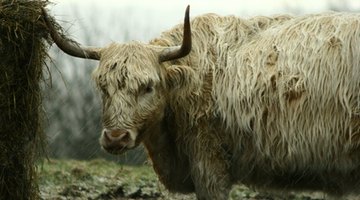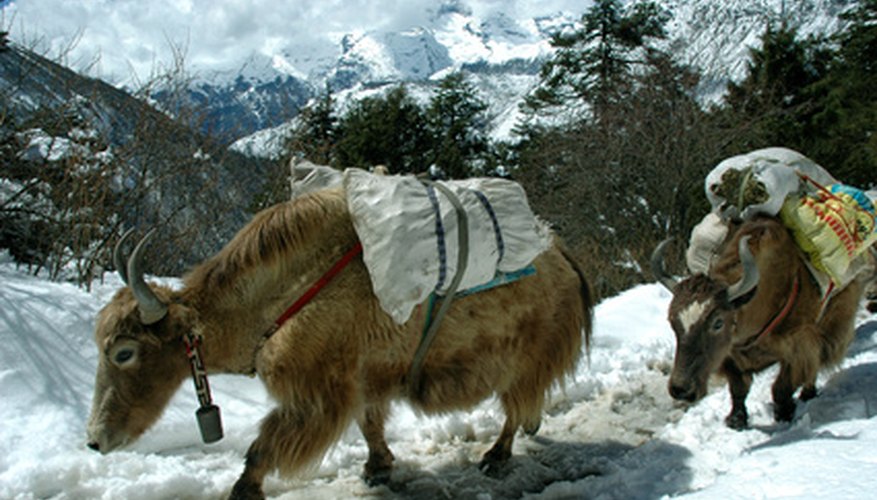Although both Highland cattle and yaks belong to the same genus, bos or oxen and true cattle, their species differ. The Highland cattle belong to the bos Taurus or true cattle species. According to the Animal Diversity Web, the yak belongs to the bos grunniens or oxen classification. Yaks can breed with cattle; however, the breeding produces fertile females and sterile male offspring.
History

Yaks originated in the mountains of Tibet in Asia. Domestication of the yak occurred up to three thousand years ago. Wild yak live mainly in the mountains of China and Tibet. Highland cattle originally came from Scotland. The black smaller Highland cattle developed on the west coast islands of northern Scotland and the red larger variety in the Scottish Highlands.
- Yaks originated in the mountains of Tibet in Asia.
Identification

A male yak may stand almost 6 feet tall at the shoulder and weigh over 907 Kilogram. Females usually weigh less than 318 Kilogram. Yaks have unique haemoglobin that allows them to live in altitudes as high as 18,000 feet above sea level. A yak has a large hump over their shoulder region and long blackish brown fur and upward curving horns. Yaks grow a thick short undercoat during the winter. Highland cattle possess long horns, and their long shaggy coat colours include red, black, yellow, dun, brindle and silver-white. Highland cattle generally measure about 3 to 3.5 feet at the shoulder; however, their weight is similar to yaks.
- A male yak may stand almost 6 feet tall at the shoulder and weigh over 907 Kilogram.
- Highland cattle generally measure about 3 to 3.5 feet at the shoulder; however, their weight is similar to yaks.
Significance
People use yaks to carry heavy loads up steep mountains. Chinese consume yak milk, eat yak meat and export it. Yak fur and hide products include clothing, tents and blankets. The health, disease resistance, lean meat production, calm temperament and low-maintenance needs of highland cattle made them desirable livestock for cattle ranchers.
- People use yaks to carry heavy loads up steep mountains.
Distribution
According to Oklahoma State University (OSU), almost 85 per cent of all yaks live in China, predominantly in the mountains. Wide-range commercial breeding in other areas of the world remains limited due to the breed’s adaptation to better survival at high altitudes. Breeding of the adaptable Highland cattle occurs in many countries, including the United States, Great Britain, Australia, Canada and Switzerland.
Future Survival
Neither Highland cattle nor domesticated yak presently face danger of extinction. Both species fill economic needs, as livestock and yaks continue to work as pack animals. Survival risks for wild yaks include lost of habitat and uncontrolled hunting. Both species live 20 years or longer in captivity.
- Neither Highland cattle nor domesticated yak presently face danger of extinction.
